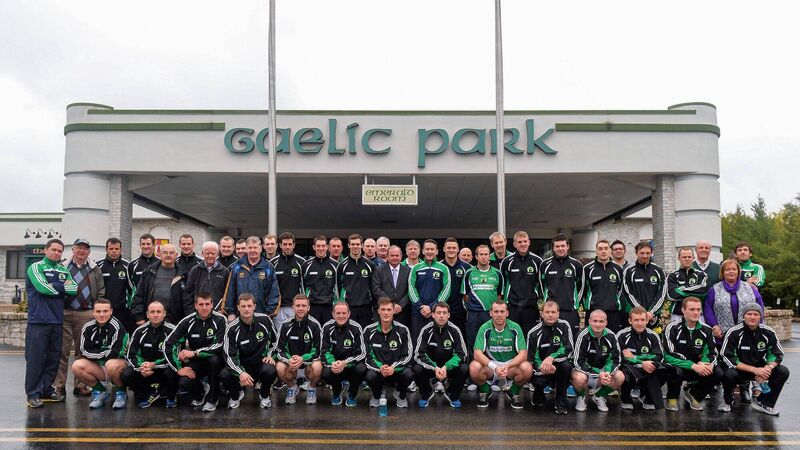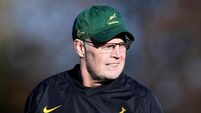John Riordan: Chicago all set for the largest and most complex logistical feat in the GAA

GROWING SPORT: 2013 - Serving Uachtarán Chumann Lúthchleas Gael Liam Ó Néill, local club officals and members of both Celtic Champions Classic Super Hurling 11s teams on their arrival at Gaelic Park. Pic: Ray McManus / SPORTSFILE
Last Sunday evening as the Kerry panel, County Board and Kingdom VIPs celebrated their All-Ireland at the Gibson Hotel, GAA President Larry McCarthy took the opportunity during his live Sunday Game interview to redirect our focus to the other 98% of the activities of the Association.
A sizable portion of that gets run off in Chicago this weekend where the four-day Continental Youth Championships began yesterday at the Windy City’s sprawling Gaelic Park venue.
As with so many large-scale events - 1,400 underage GAA players and almost as many parents /coaches are flying in from across North America this week - here we have yet another happy reunion. The CYC has been stifled by Covid since 2019, knocking out of whack the treasured summer traditions of a couple thousand GAA families.
That last time three years ago, it was held in Philadelphia and McCarthy was a field marshall on the Under 8s field. A lot has changed since then.
I teed up this event last week by focusing on the work of Colm Egan in the host city but he was at pains to deflect to the army of volunteers required to set up 12 specially marked fields which were undergoing 24 hours of watering to offset the brutal midwest heatwave.
The freshly painted goalposts and freshly painted flags. The countless hotel rooms clustered strategically near Chicago Midway (“these families aren’t flying in for tourism”) and the all-important buses which are crucial to the 8am throw-ins going off without a hitch.
Almost a year in the making (if not three), it’s a mammoth exercise in logistics and one that CYC Board Chair Paul Mulcaire regards as the largest and most complex in the GAA.
“Until you see it in person, you can't imagine how big it is,” the Kilrush native told me last week from his home in Buffalo where he has lived since 1986.
Mulcaire, who has a bloodline via his great grandmother to Limerick great Mick Mackey, started bringing Buffalo youngsters to the CYC in 2013 almost a decade after its inception, an experience which inspired him to get more involved. “He didn't pass any of the skills down the line. The love of the GAA he did pass on,” he laughs of his famous relative.
Both Mulcaire and Egan are at pains to point out that the CYC is the sole example of where cooperation between the three County Boards in North America is possible. The USGAA and New York, in particular, have never really managed to get their top teams interlocking, partly due to schedules being a little different but also partly due to the grand old tradition of a tendency towards turf war. Canada, as ever, happily co-exists.
But naturally, noble unity sets off logistical headaches that spell six months of dedicated untangling. Without a single registration system to work off, it’s Mulcaire’s job to prod and push and motivate everyone through the reams of paperwork with the promise that the last weekend in July will be a special one. Heavily supported by Croke Park, the pressure to succeed is compounded on both sides of the pond.
“We created a beast, and now we've got to tame it,” he says more than once. “We had to pull in the reins a little bit for this year and be realistic about what to expect from each team. We don't want to exclude anybody from the tournament.”
So that will mean adjusted team sizes, for example, if necessary. Normally the CYC can expect 2,200 players but three years is a long time in a young person’s life.
While CYC has been away, Egan notes, families have developed other interests, not least of which is treasured time back in Ireland after having been so suddenly denied the opportunity to travel.
“We had a captive audience and Gaelic Games was their summer,” he added. “it was taken away from us a little bit. So if CYC 2022 Is about anything, it's about getting back out on the field, it's about presenting to our families and our players, our children that we are here, we are absolutely organised, we are promoting our games and we are ready again to play our games to high levels.”
For both Egan and Mulcaire, there is an added pride that the Under 8s and Under 10s of the early and mid 2010s are now adult players, still playing the game at either the highest level possible or the most enjoyable level available. The biggest collective prize on offer is development.
“Our teams are very competitive, from Under 9s, right the way up, you'd think it's the All-Ireland final. They want that kind of competition because it's once a year for them that they get to test themselves against other counties.
“But the goal has to be that the development does not finish unless they're actually playing adult after they age out. Covid actually helped us in the aspect that we couldn't get the sanction players out here.”
Mulcaire and Buffalo hosted the CYC in 2017, created a youth program that participated in it and from that, an adult team which ultimately won the Junior D championship at the USGAA Nationals last year. It was one of his proudest moments.
Another less parochial event he'll always pride himself in is the 2020 County Final in New York where he watched familiar CYC players of the past gather together in the St Barnabas colours to become the first ever American-born team to win the Senior Football Championship in the Bronx. A lot of those players were in Croke Park the other week for the All-Ireland Junior final defeat to Kilkenny.
Egan, meanwhile, has an army of CYC products he wants me to talk to. There’s Michael Collevy whose Southside Chicago club, St Jarlath's, traditionally challenged the likes of Barnabas as they collectively came of age.
He and his siblings inherited the love of the game from his Galway-born father who hails from current county football champions, Mountbellew.
And there is Collevy’s former teammate, Mairead Ruane, who up until Under 14s got to play with the Jarlath's boys until she was denied the chance by a rule change.
“Yeah, she's very good,” said Collevy. “Probably from being pushed around by all of us.”
“They’re my best friends now,” Ruane told me this week. “And they would do anything for me. I was very sad after that rule came in where the girls can't play with the boys anymore.”
Mercifully, a San Francisco girls team kept the opportunity to play at CYC alive for Ruane when she was a young teenager and she was allowed to continue to develop as a footballer.
Collevy’s senior club Wolfe Tones were surprisingly knocked out of the local championship and will miss the nationals next month, also hosted by Chicago. And Ruane is now one of the top players in the country lining out at centre forward for St. Brigid's who will be favoured on home turf when the USGAA's top senior ladies football teams clash.
“My friends that I grew up with going to school, they know better. They're not going to see me the whole summer because it's all about playing football. The winters are so long and all you want is for the summer to get here as soon as possible.
“My first CYC trip was Under 8s in Boston. And it’s crazy because last summer I played a senior North American final on the same pitch, almost 13 years later. Just a crazy experience. But yeah, I love it so much.”
Now Ruane is part of the massive volunteer effort being deployed this weekend. She’ll be refereeing a couple of games (“Colm wouldn't let me get away without helping out”) but she would have been attending anyway because a final family connection to the CYC will be having her last game as a minor. “I wouldn't miss it.”
After the final of Sunday’s finals, the three-week countdown will begin for the adult Nationals on the same fields. Egan and his team will break down the juvenile goals and change the field markings so that 12 becomes six.
And then it starts all over again.
“Whatever we're able to put together after a successful CYC, that will have to sustain us for four years before we have it again. We'll put it back into games development, back into the clubs to ensure that they have equipment, that they have the ability to recruit and that they have the ability to get the coaches in place to keep growing the game.”








